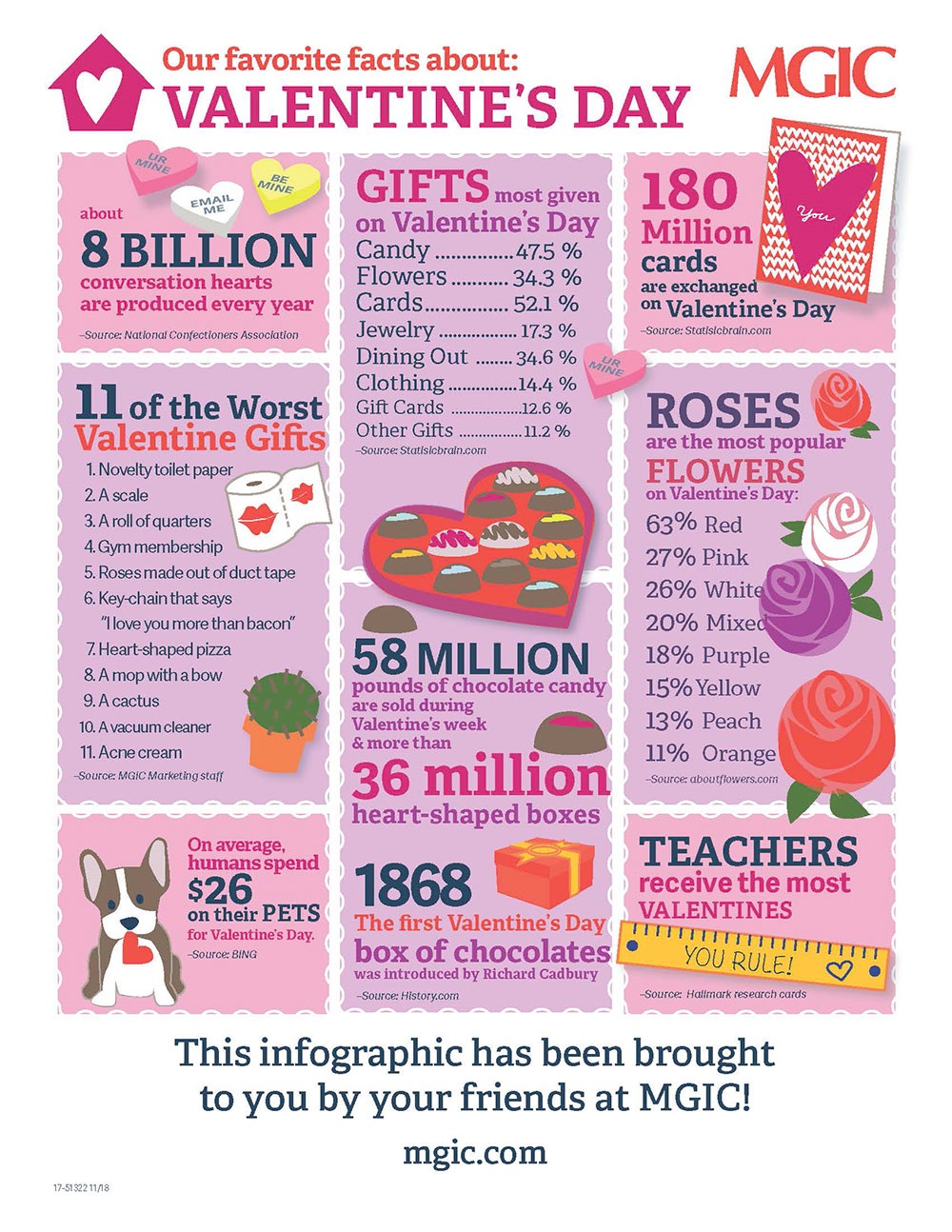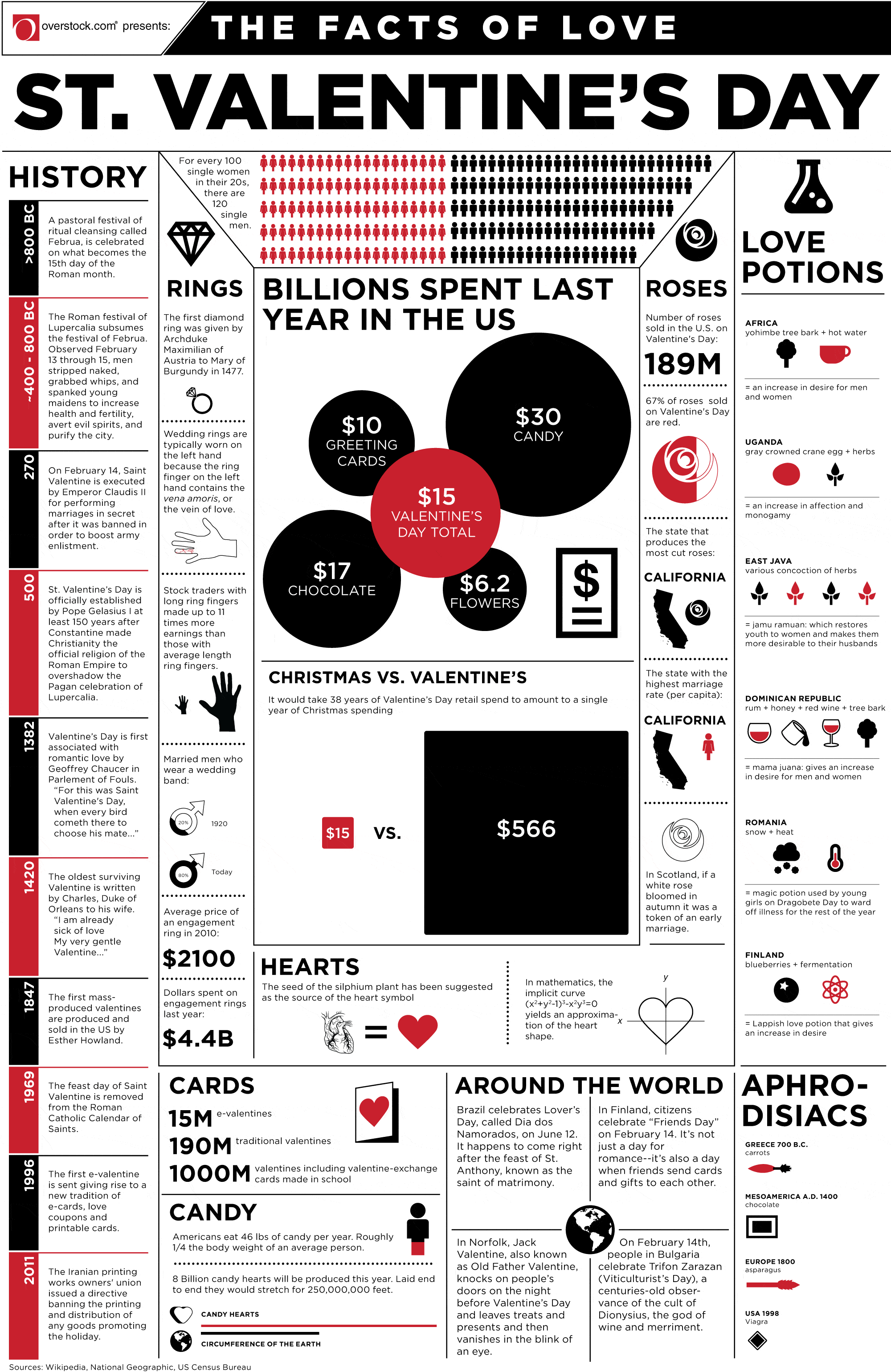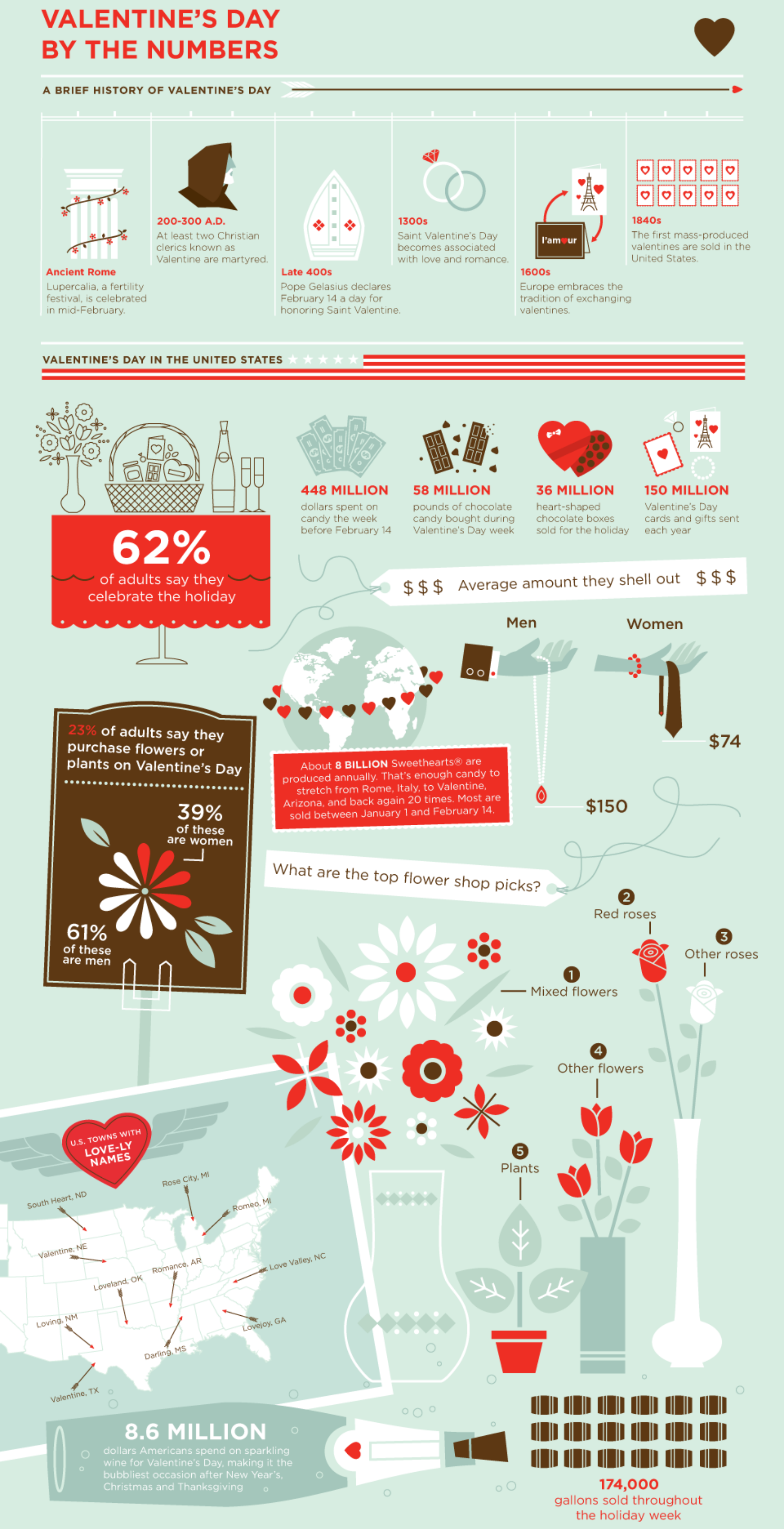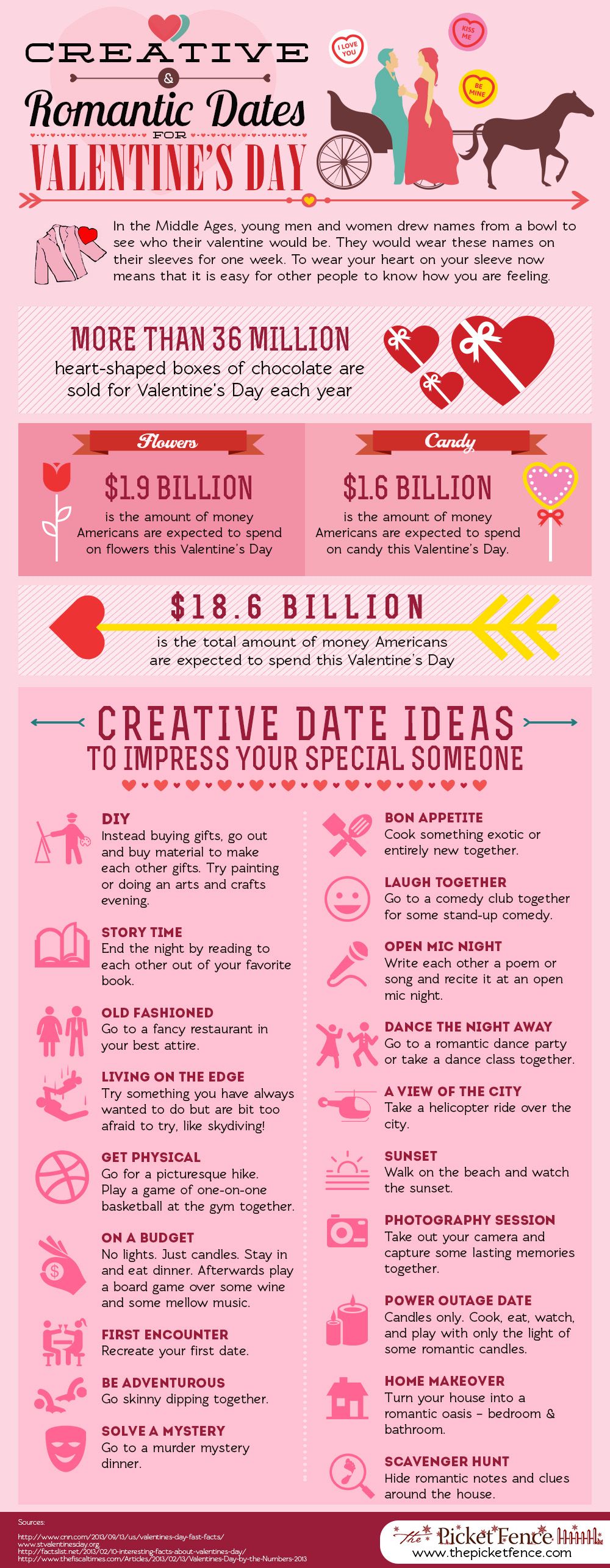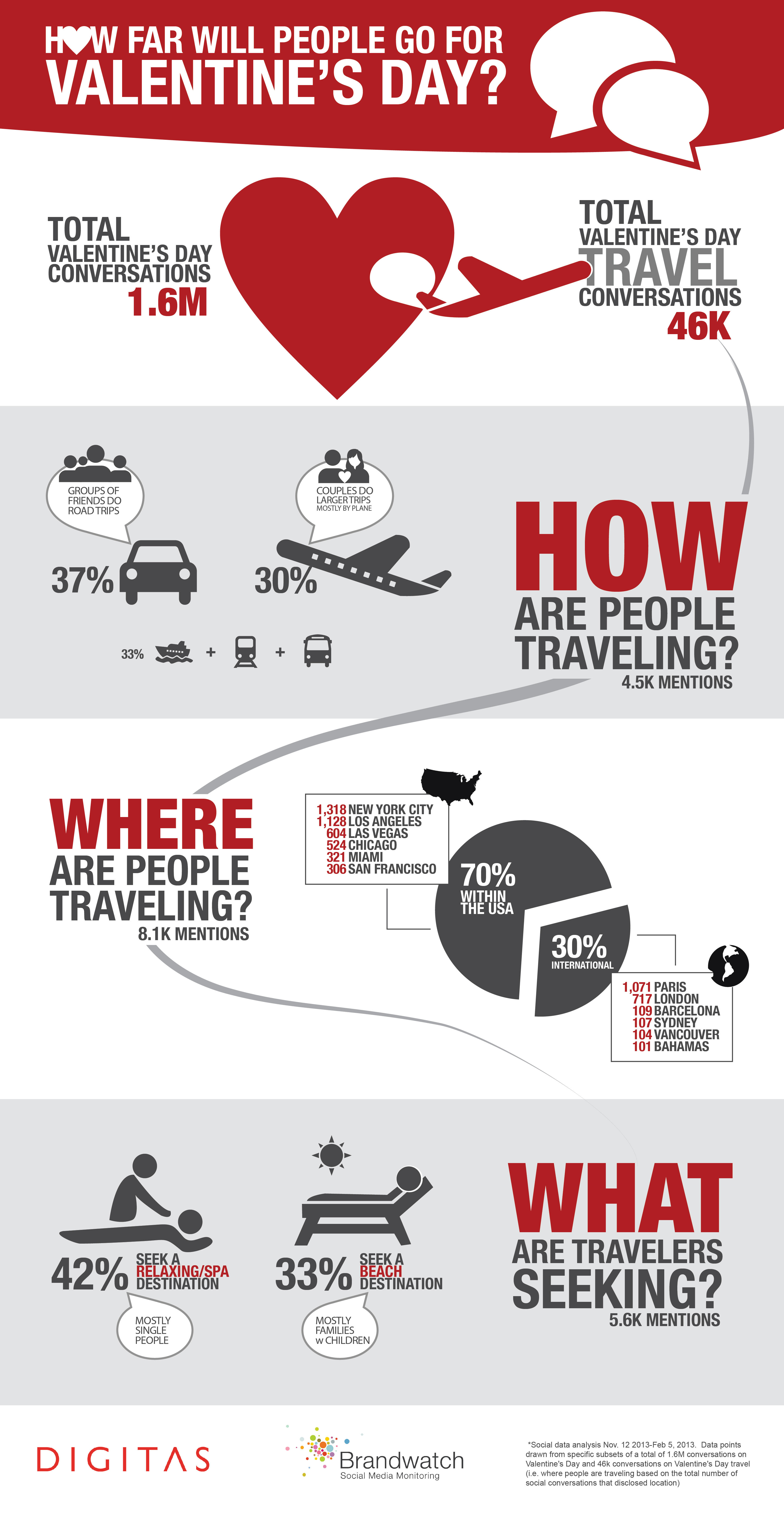Valentine’s Day is dedicated to celebrating love and affection between intimate companions. It is celebrated annually on February 14th and is widely recognized as a day for couples to express their feelings for one another. However, the origins and customs of Valentine’s Day have evolved over time, leading to various interpretations of the holiday across different cultures.
To understand the various aspects of Valentine’s Day, we’ve compiled a collection of 20 interesting Valentine’s Day infographics that cover a wide range of topics, from the history of Valentine’s Day to the most popular gift ideas, from romantic destinations to the worst excuses for not celebrating, and more. So, whether you’re a seasoned romantic or just curious about the holiday, this article has something for everyone.
1. Facts About Valentine’s Day
The infographic offers various facts and information related to Valentine’s Day. The information is presented in an easy-to-read format using images, charts, and text. It includes details such as popular gifts, the worst Valentine’s gifts, and spending trends. Additionally, it provides interesting trivia related to the holiday.
2. The Facts of Love St. Valentine’s Day
This infographic offers a comprehensive overview of Valentine’s Day, covering its history as a Roman festival of Lupercalia and its association with Saint Valentine, who secretly married couples during a time when the Roman Empire forbade marriages.
In addition, it highlights the most popular gifts exchanged on occasion, such as chocolates, flowers, jewelry, and restaurant dinners. This makes it an excellent resource for anyone seeking to learn more about the origins and customs of this holiday, which celebrates love and affection. As such, it offers a useful starting point for anyone looking to deepen their understanding of this celebration of love and romance.
3. Valentine’s Day – Facts of Love
The infographic provides information about the history and customs of Valentine’s Day. This infographic shows a comprehensive overview of various aspects of Valentine’s Day, including its history and spending habits, making it a useful resource for those looking to learn more about this holiday and the love and affection it celebrates.
4. A Few Fun Facts About Valentine’s Day
The infographic about “A Few Fun Facts About Valentine’s Day” demonstrates interesting and unique information about the holiday, making it a useful resource for those looking to learn more about this holiday and its many traditions and customs.
It starts with a brief history of the holiday. Then comes about a famous phrase “to wear your heart on your sleeve.” The infographic highlights some popular customs and traditions associated with Valentine’s Day, such as exchanging cards, chocolates, and flowers. It also mentions that the holiday is celebrated in many countries around the world.
5. Valentine’s Day By the Numbers
The infographic “Valentine’s Day By the Numbers” offers statistics and data related to the holiday.
The main focus of the infographic is on presenting various data points related to Valentine’s Day spending, including the expected total expenditure on gifts, the average amount spent per person, and the most popular gifts purchased. It also shows a breakdown of the types of gifts bought, with the largest percentage being chocolates and sweets, followed by cards, flowers, and jewelry.
6. A Brief Guide to Sex, Health, and Romance on Valentine’s Day
Another one of the excellent infographics “A quick guide to sex, health, and romance on Valentine’s Day” offers useful information and advice on various aspects of sexual and romantic health on Valentine’s Day. The infographic uses illustrations, diagrams, and text to present information in a visually appealing and easy-to-understand format.
7. Valentine’s Day Tradition From Around the World
This infographic showcases various Valentine’s Day traditions from different countries and regions. It presents the information in a colorful and attractive format, with illustrations and text highlighting the unique customs and practices associated with the holiday.
The infographic covers a range of countries, from the United States to Europe to Asia, and provides information on the history, symbols, and customs associated with Valentine’s Day in each place. It also includes facts about the holiday, such as its origin and the different ways it is celebrated worldwide. The overall message of the infographic is to showcase the diverse ways people around the world observe and celebrate Valentine’s Day.
8. Ways to Make Your Valentine’s Day Unforgettable
This infographic displays various suggestions for making Valentine’s Day memorable and unique. The suggestions include traditional romantic gestures such as couples’ spa treatments, candlelit dinners, and long walks. It also includes unique and creative ideas for couples.
The infographic features colorful illustrations and is presented in an attractive format. Overall, the infographic aims to inspire people to think outside the box and find new and creative ways to celebrate the holiday of love.
9. Creative Valentine’s Day Date Ideas
It provides a list of unique and creative date ideas for Valentine’s Day. It includes ideas such as a first encounter, a home-cooked candlelit dinner, a photography session, a picturesque hike, dances the night away, and more.
Each idea is accompanied by a visually appealing illustration to showcase the concept in a fun and playful way. The infographic is meant to inspire couples to think outside the box and come up with unique ways to celebrate their love on Valentine’s Day.
10. Valentine’s Day for Love or for Money?
This infographic shows how much effort and money people in love spend on love. The infographic is designed to provide a clear and concise overview of the topic and help the viewer understand the relationship between Valentine’s Day and spending habits.
In general, the aesthetics of this infographic fit the theme. It helps to visualize data and is excellent at keeping things nice and concise.
11. Top Valentine’s Day Gifts
The “Top Valentine’s Day Gifts” infographic displays the results of a survey on the most popular Valentine’s Day gifts in several countries around the world. It lists the top gifts for each country and provides a visual representation of the data in the form of graphs, charts, or maps. It lists the top gifts, including chocolates, flowers, jewelry, a romantic dinner, and a surprise getaway. Each gift is accompanied by a percentage showing the number of respondents who selected it.
The infographic aims to provide a comprehensive and visually appealing overview of the topic, making it easy for the viewer to compare and contrast the different gift-giving practices for Valentine’s Day across the globe.
12. 10 Gift Ideas for Woman on Valentine’s Day
Another one of the greatest infographics provides a list of 10 jewelry gift ideas for women to celebrate Valentine’s Day. The gifts range from classic necklaces and earrings to more unique choices like bracelets and rings. The jewelry pieces are selected to cater to various styles, budgets, and preferences, and an image and a brief description accompany each gift.
The infographic is designed to help the viewer choose a jewelry gift that is both stylish and meaningful and reflects their love and appreciation for the remarkable woman in their life. The information is presented in an appealing format, making it easy for the viewer to understand and remember the different options. The infographic provides inspiration and ideas for a special jewelry gift for Valentine’s Day.
13. Valentine’s Day: The Meaning of Gifts
The “Valentine’s Day: The Meaning of Gifts” infographic provides an overview of the different meanings and interpretations of gifts on Valentine’s Day. It explains the symbolism behind popular gifts like flowers, chocolates, and jewelry and offers insights into gift-giving’s cultural and historical significance on Valentine’s Day. The information is presented in a clear and concise format, making it easy for the viewer to understand the topic.
The infographic helps to understand the cultural and emotional significance of gift-giving on Valentine’s Day and choose meaningful gifts representative of their love and appreciation for their significant other.
14. The Relationship Between Valentine’s Day and the Gift You Receive
This infographic explores the connection between the type of gift received on Valentine’s Day and the state of the relationship. It presents data and insights on the correlation between the type of gift and factors such as the length of the relationship, the level of commitment, and the level of affection.
The infographic also contains examples of appropriate gifts for different stages of the relationship. The infographic guides choosing the right gift for Valentine’s Day based on the state of the relationship. It helps the viewer understand gift-giving’s role in building and maintaining solid relationships.
15. How Far Will People Go For Valentine’s Day?
The “How Far Will People Go For Valentine’s Day?” infographic analyzes the distances people are willing to travel in order to celebrate this holiday. It showcases data and perspectives on travel patterns, expenses, and rituals related to Valentine’s Day.
The infographic demonstrates the most common and unusual destinations for Valentine’s Day trips and explores how cultural and regional differences influence travel choices for a holiday. It highlights the impact of Valentine’s Day on people’s relationships and daily lives and encourages the viewer to reflect on their travel habits and attitudes towards the holiday.
16. Romantic European Destinations for Valentine’s Day
This infographic features five popular romantic destinations in Europe: Venice, Budapest, Paris, Florence, and Bruges. It presents information on the romance-related offerings of each city.
The infographic aims to offer inspiration and guidance for couples looking for romantic destinations in Europe for Valentine’s Day and to highlight the unique and memorable experiences each city has to offer. It also encourages the viewer to consider these destinations for their next romantic getaway and reflect on their preferences and interests in romantic travel.
17. Facebook Valentine’s Day Trends
It is a visual representation of data and insights related to the usage of Facebook around Valentine’s Day. The information is presented in a clear and accessible format using charts, graphs, or illustrations.
It also explores how people use Facebook to celebrate the holiday. The infographic aims to provide a snapshot of the role Facebook plays in people’s celebration of Valentine’s Day and to understand the holiday’s emotional, social, and cultural significance.
18. Facts About Romantic Movies This Valentine’s Day
Another one of the most useful infographics represents data and insights about romantic movies during the Valentine’s Day season. It shows the information on the top five Valentine’s movies, IMDB rating, the “most watched” romance movies on Facebook, the most “successful” romance dramas of all time, the most famous movie scene ever made, and romantic movies that pocketed the most awards. The information is presented in a clear and accessible format using illustrations.
The infographic provides a comprehensive overview of the romantic movie genre and to understand its significance and impact during the Valentine’s Day season. It also aims to highlight the emotional and cultural implications of romantic movies on viewers and to encourage the viewer to reflect on their own experiences and preferences related to romantic movies.
19. Cellphone & Web the New Valentine’s Day Cupids
The “Cellphone & Web: The New Valentine’s Day Cupids” infographic is a visual representation of data and insights on the role of technology in modern-day Valentine’s Day celebrations. It shows how people use their smartphones, social media, and other digital platforms to celebrate and express their love on Valentine’s Day.
The information is presented in a clear and accessible format using illustrations. The main goal of the infographic is to provide an overview of the impact of technology on modern-day Valentine’s Day celebrations and to understand how technology has changed the way people express their love and affection.
20. Worst Valentine’s Day Excuses
Finally, this infographic represents common excuses used by people to avoid celebrating Valentine’s Day. It shows a glimpse into the attitudes and behaviors associated with Valentine’s Day and to understand why some people may not celebrate the holiday. It also aims to encourage the viewer to reflect on their experiences and attitudes towards the holiday and understand that not everyone may have the same feelings about it.
It presents data and insights on why some people may choose not to participate in the holiday or may not want to show their love and affection on this day. The infographic demonstrates the most common excuses and reasons and offers a humorous or lighthearted approach to the subject.


